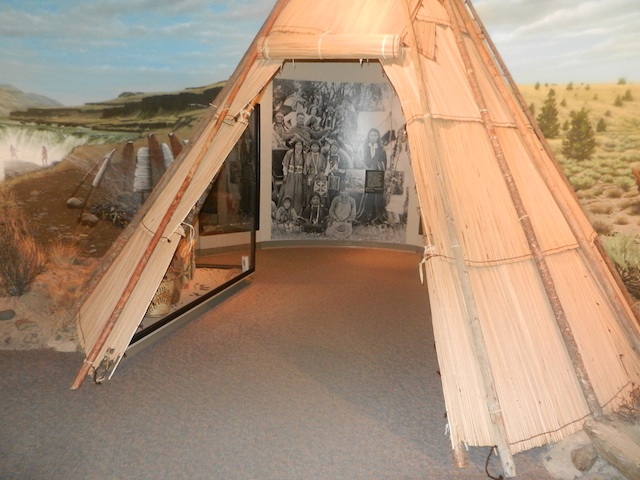While traveling between Bend, Oregon and the base of Mt. Hood at Government Camp along remote Highway 26, one might think there’s nowhere worthy of a pit stop. Not so! The Museum at Warm Springs is nothing short of a high desert gem. Located inside the Confederated Tribes of Warm Springs reservation, the museum is tucked on the side of the road near a gas station and across from the small Indian Head Casino. We’ve driven by without a glance more than once before taking the time to visit following a stay at nearby Kah-Nee-Ta Resort and Spa.

We were treated to a private tour of the museum, but visitors self-guiding will have no problem getting much out of this museum as well. Every aspect of the design has been consciously considered; in fact, the museum has won honors for its presentation. Even at the entrance, the symbolism is evident in the drum-circle arc of a front patio and brickwork depicting basket-weaving design. The interior vestibule is shaped like a long house, and a bubbling stream accompanies guests up the front walk, reminding all of the life-giving importance of water.
Inside, the museum houses collections garnered over the past 20 years from tribal members living in the area. The exhibits are incredibly well-done, and take guests from early life on the high desert and Columbia Basin through reservation life in present day. Our favorite section included a small, circular room where visitors can listen to intertribal and single tribal songs and drum beats, along with the viewing of dances on a screen.
The day-to-day ancient living of the Wasco, Warm Springs, and Paiute tribes are depicted through displays featuring lifelike models. In fact, we learned that these human replicas were created by applying molds to the faces of today’s tribal members, which were used to make the models. Guests can tour behind open displays of Native American dwellings, including teepees and buildings, to see what a traditional interior looked like. We learned about the many variations of baskets and their purposes and deeper meanings, as well as the weapons, hunting practices, and fishing practices of the native people.
An entire room is devoted to a timeline of the shift from traditional life to reservation life, starting with the Treaty of 1855 and carrying on to today. Learning how the tribal land was distributed, how three distinctly different tribes came to be located on the same reservation, and how early reservation life–including the injustice of boarding schools and the stripping of the native language from young people of the tribes–effected the native people was but well-depicted and sobering.
There are a number of hands-on activities for kids, as well as many multi-media presentations to keep them engaged. The museum is best for school-aged kids, but even preschoolers will get much out of it. Tip: on your way out, look for the single missing ‘bead’ in the brickwork on the outside of the building. In Warm Springs intertribal culture, every traditional basket and beadwork design has one mistake in it, to symbolize that nothing is perfect, and this symbolism is carried over in the museum architecture. It’s hard to spot!
Table of Contents
Distance from the interstate:
Directly on Highway 26, approximately one hour from Highway 97 in Bend or almost 2 hours from I-84.
Admission and hours:
The museum is extremely affordable at $7 for adults, $4.50 for students (13-17), and $3.50 for kids (age four and under are free). Open 9 am to 5 pm daily in the spring/summer season. Check site for winter hours.
Food services:
No food services on-site, though there are nice picnic areas and a short walking trail. Families could easily make this a picnic lunch stop and museum visit.
Directions:
From Bend, proceed north on Highway 97 past Redmond (15 miles) and Madras (26 miles) to Warm Springs (14 miles). From Portland, travel Highway 26 past Mt. Hood (45 miles). 105 miles total.
Disclaimer: We experienced the Museum at Warm Springs as guests of the museum.





